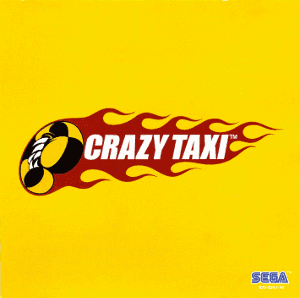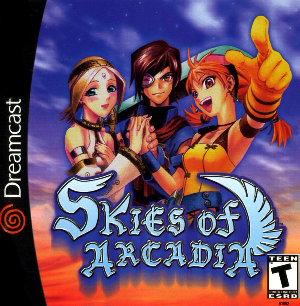
Worms is a series of artillery tactical video games developed by British company Team17. In these games, small platoons of anthropomorphic worms battle each other across a destructible landscape with the objective being to become the sole surviving team. The games are noted for their cartoony animation and extensive use of surrealism and slapstick humour.

The Nintendo GameCube is a home video game console developed and marketed by Nintendo. It was released in Japan on September 14, 2001, in North America on November 18, 2001, in Europe on May 3, 2002, and in Australia on May 17, 2002. It is the successor to the Nintendo 64. As a sixth-generation console, the GameCube primarily competed with Sony's PlayStation 2, Sega's Dreamcast and Microsoft's Xbox.

Crazy Taxi is a racing video game developed and published by Sega. It is the first game in the Crazy Taxi series. The game was first released in arcades in 1999 and then was ported to the Dreamcast in 2000. Gameplay is based on picking up taxi customers and driving to their destination as quickly as possible. Reception to Crazy Taxi has been mostly positive. It was ported to other platforms numerous times, including the PlayStation 2 and GameCube by Acclaim in 2001, and then Windows in 2002, becoming Sega's first multi-platform game after the company transitioned to third-party.

Sonic Heroes is a 2003 platform game developed by Sonic Team USA and published by Sega as part of the Sonic the Hedgehog series. The player races a team of series characters through levels to amass rings, defeat robots, and collect the seven Chaos Emeralds needed to defeat Doctor Eggman. Within each level, the player switches between the team's three characters, who each have unique abilities, to overcome obstacles. Sonic Heroes downplays the action-adventure and exploration-based gameplay of its predecessors Sonic Adventure (1998) and Sonic Adventure 2 (2001) in favor of returning to the linear style of Sega Genesis-era Sonic games.

Phantasy Star Online is an online role-playing game (RPG) developed by Sonic Team and published by Sega in 2000 for the Dreamcast. It was the first successful online RPG for game consoles; players adventure with up to three others over the internet to complete quests, collect items and fight enemies in real-time action RPG combat. The story is unrelated to previous games in the Phantasy Star series.

Skies of Arcadia is a 2000 role-playing video game developed by Overworks and published by Sega for the Dreamcast. Players control Vyse, a young air pirate, and his friends as they attempt to stop the Valuan Empire from reviving ancient weapons with the potential to destroy the world.
In the history of video games, the sixth generation era is the era of computer and video games, video game consoles, and handheld gaming devices available at the turn of the 21st century, starting on November 27, 1998. Platforms in the sixth generation include consoles from four companies: the Sega Dreamcast (DC), Sony PlayStation 2 (PS2), Nintendo GameCube (GC), and Microsoft Xbox. This era began on November 27, 1998, with the Japanese release of the Dreamcast, which was joined by the PlayStation 2 on March 4, 2000, the GameCube on September 14, 2001 and the Xbox on November 15, 2001, respectively. The Dreamcast was among the first to be discontinued in 2001, followed by GameCube in 2007, Xbox in 2009, and PlayStation 2 in 2013. Meanwhile, the seventh generation of consoles started on November 22, 2005, with the launch of the Xbox 360.

Soulcalibur II is a 2002 arcade fighting video game developed and published by Namco. It is the third installment in the Soulcalibur series of weapon-based fighting games as the sequel to Soulcalibur (1998). Originally intended to be released on Sega's NAOMI arcade board, the game was built on the Namco System 246 board before being ported to the PlayStation 2, GameCube, and Xbox home consoles.

Worms Armageddon is a 1999 turn-based strategy video game developed and published by Team17 as part of the Worms series. It was originally released for the Microsoft Windows operating system, and was later ported to the PlayStation, Dreamcast, Nintendo 64, and Game Boy Color. In the game, the player controls a team of up to eight earthworms tasked with defeating an opposing team using a wide range of weapons at their disposal. The game takes place on a destructible and customizable two-dimensional board and is characterized by cartoonish graphics and a unique brand of humour.
2001 saw many sequels and prequels in video games, such as Madden NFL 2002, NBA Live 2002, NBA 2K2, WWF Smackdown! Just Bring It, Capcom vs. SNK 2,Dead or Alive 3, Final Fantasy X, Gran Turismo 3: A-Spec, Grand Theft Auto III, Metal Gear Solid 2: Sons of Liberty, Myst III: Exile, Crazy Taxi 2, SSX Tricky, Super Smash Bros. Melee, Sonic Adventure 2, Tony Hawk's Pro Skater 3, and Virtua Fighter 4. New intellectual properties include Ace Attorney, Advance Wars,Animal Crossing, Burnout, Gothic, Black & White, Devil May Cry, Fatal Frame, Ghost Recon,Halo, Jak and Daxter, Max Payne, Oni, Onimusha: Warlords, Operation Flashpoint, Pikmin, Pro Evolution Soccer, Red Faction, Serious Sam, and Tropico.
The Creative Assembly Limited is a British video game developer based in Horsham, founded in 1987 by Tim Ansell. In its early years, the company worked on porting games to MS-DOS from Amiga and ZX Spectrum platforms, later working with Electronic Arts to produce a variety of games under the EA Sports brand. In 1999, the company had sufficient resources to attempt a new and original project, proceeding to develop the strategy computer game Shogun: Total War which was a critical and commercial hit, and is regarded as a benchmark strategy game. Subsequent titles in the Total War series was built following the success of Shogun: Total War, increasing the company's critical and commercial success.

Worms World Party is a 2001 artillery turn-based tactics video game developed by Team17, and is the sequel to Worms Armageddon in the Worms series. As with the previous games in the series, players take turns controlling their teams and using available projectiles, firearms, explosives, and equipment to destroy all opposing teams and manoeuvre across a specified and highly destructible map.

Worms 4: Mayhem is a 3D artillery turn-based tactics video game developed by Team17 and published by Codemasters and Majesco Entertainment. It is the eighth installment in the Worms series, and the successor to Worms 3D. The game was released in 2005 for PlayStation 2, Xbox and Windows.

Sega Soccer Slam, also known as simply Soccer Slam, is a sports game released for GameCube, Xbox, and PlayStation 2 in 2002.

NFL 2K3 is an American football video game released in 2002 for PlayStation 2, Xbox, and GameCube. It was developed by Visual Concepts and published by Sega. It is the only NFL 2K game for the GameCube. The cover athlete features Brian Urlacher of the Chicago Bears, becoming the first cover athlete in the NFL 2K series besides Randy Moss.

Worms is a 2D artillery tactical video game developed by Team17 and released in 1995. It is the first game in the Worms series of video games. It is a turn based game where a player controls a team of worms against other teams of worms that are controlled by a computer or human opponent. The aim is to use various weapons to kill the worms on the other teams and have the last surviving worm(s).

Worms Forts: Under Siege is a 3D artillery tactical game developed by Team17. A follow-up to the previous Worms game, Worms 3D, Forts showcases new features. While the primary method of victory is to destroy the opposing team, victory can also be achieved by destroying the opposing "Stronghold", the most important building in the game.

Majesco Entertainment Company is an American video game publisher and distributor based in Hazlet, New Jersey. The company was founded as Majesco Sales in Edison, New Jersey in 1986, and was a privately held company until acquiring operation-less company ConnectivCorp in a reverse merger takeover, becoming its subsidiary and thus a public company on December 5, 2003. ConnectivCorp later changed its name to Majesco Holdings Inc. on April 13, 2004.

Worms W.M.D is a 2D artillery turn-based tactics video game developed and published by Team17. It is the nineteenth installment in the Worms series, and was released on 23 August 2016 for Linux, OS X, PlayStation 4, Microsoft Windows, and Xbox One. It was later released on 23 November 2017 for Switch, on 1 July 2022 for Stadia and on 11 April 2023 for iOS and Android.

















